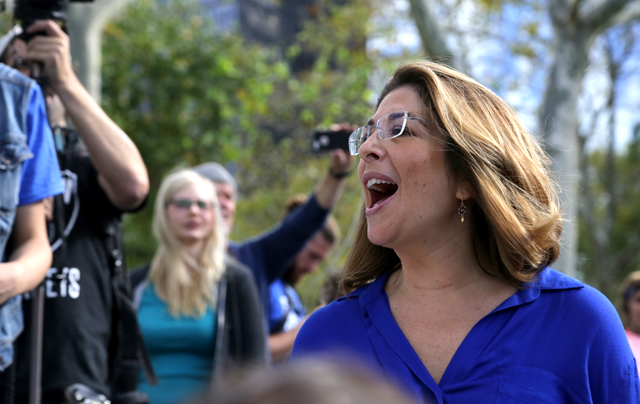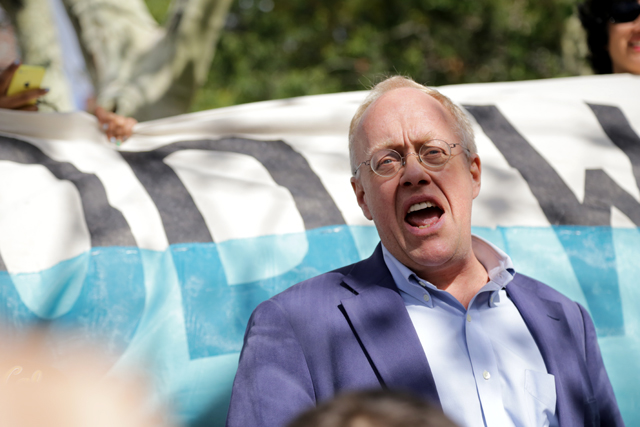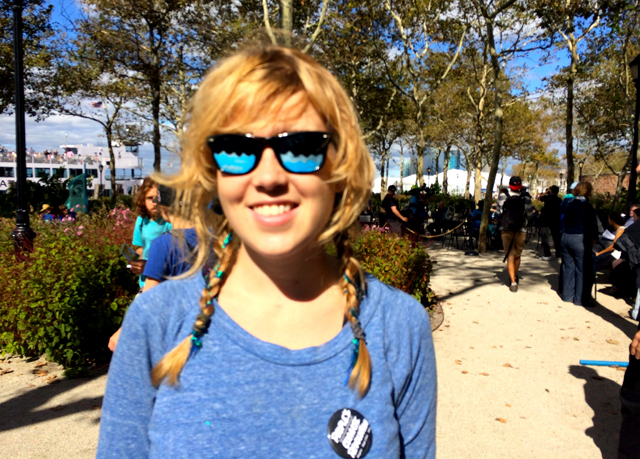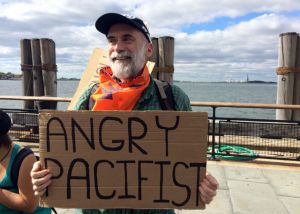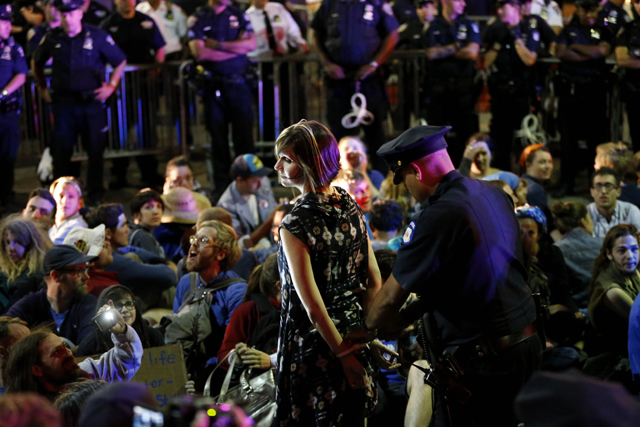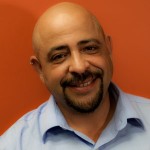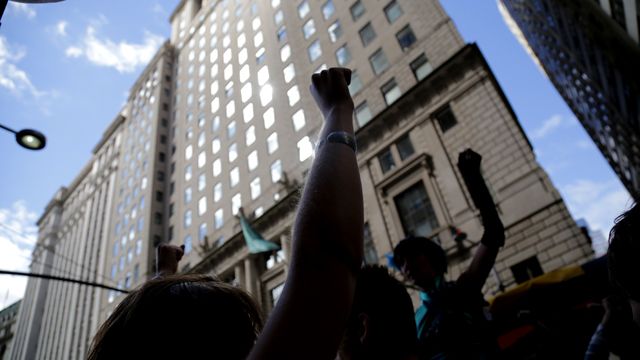
On Monday, a day after an estimated 300,000 to 400,000 people participated in the People’s Climate March in New York, a smaller group of activists set out to shut down Wall Street.
The day began with a festive atmosphere, and ended with clashes between protesters and police, who dispersed pepper spray and made dozens of arrests. Some of those arrested had planned on being detained as an act of civil disobedience; others were caught in the fray as tensions heated up during the afternoon.
Earlier in the day, heirs to the Rockefeller family — which made its vast fortune from oil — announced their philanthropic organization is to sell off their investments in fossil fuels and reinvest in clean energy, joining a growing global initiative called Global Divest-Invest.
The day’s events began with a rally, dubbed “Flood Wall Street,” in Manhattan’s Battery Park. Authors Naomi Klein and Chris Hedges, as well as several grassroots activists from parts of the world that have already felt the acute effects of global warming, fired up a crowd that organizers said numbered between 2,000 and 3,000.
(The idea of flooding wall street is not an empty metaphor — by 2050, a significant portion of the financial district will be vulnerable to a rising sea as global warming progresses.)
“We are powered by the knowledge that the same system of short-term profit and deregulated greed that deepens inequality and forecloses on homes is the very same system that is foreclosing on our collective home,” said Klein, who argues in her new book, This Changes Everything: Capitalism v. the Climate, that the time for “politely” lobbying our elites to address the crisis has passed. “Yesterday we heard calls for action. We don’t just want action from our elites, we demand justice from below.”
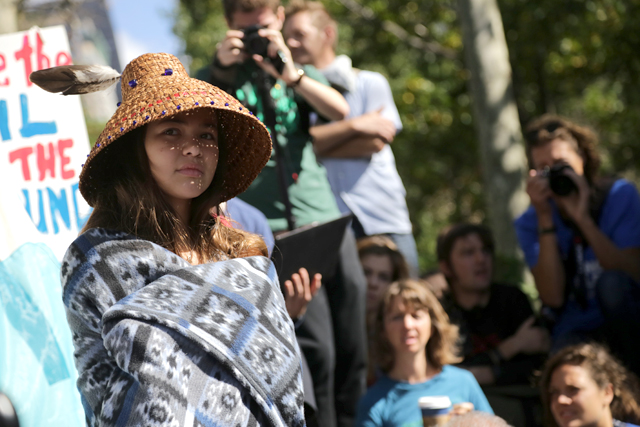
Ta’Kaiya Blaney, a 12-year-old singer-songwriter from the Sliammon First Nation in Canada. (Photo: John Light)
“We have seen some of the most devastating industrial attacks of destruction — and when I say ‘we have seen,’ by ‘we’ I mean the youth,” said Ta’Kaiya Blaney, a 12-year-old singer-songwriter from the Sliammon First Nation in Canada, addressing the crowd. “The time to speak up was yesterday and the days before. The time to act is now.”
“Up that road lies the Emerald City of Wall Street,” declared Hedges. “In that city, the wizards of finance profit from the death of the planet. The wizards own the press, the politicians, the courts and the government. No one will stop them but the people. We are the people — this means revolution!”
The atmosphere was reminiscent of the mostly dormant Occupy Movement — and it was clear that many of the activists were veterans of Occupy Wall Street. Speakers used a “human mic” to get the crowd up to speed on the strategy for the day, with one individual shouting instructions and the crowd repeating them back for everyone to hear. Organizers planned a series of maneuvers that they hoped would bring them to the heart of Wall Street.
The protesters wanted to highlight the connection between a warming planet and the dominant form of lightly regulated capitalism. “The people who are profiting from the destruction of our planet are all on Wall Street, said 29-year-old Kate McNeely of New York City, who planned on being arrested. “We’re running out of time, and people need to listen.”
“I feel like this is a natural extension of the People’s Climate March,” McNeely said. “In the long tradition of nonviolent action, we’re saying that we not only have the numbers, but also the strength to hold fast until our leaders not only take action against climate change but also stop allowing the future of our planet being dictated by large corporations.”
“I’m a botanist professionally, and I work on endangered native plant species, and climate change is having a big effect, said 52-year-old Richard Lynch. “And it’s not just rising sea levels — the fauna and flora of our country is changing. And as someone who cares about these issues, I felt that I needed to be here.” Lynch said that he had been arrested 15 times during three years with Occupy Wall Street.
“I feel very strongly that the banks and the stock exchange are at the core of so many of the issues that other activists are working on. I want to stand up for them as well — there are a lot of people who would be here if they could.”
As the protesters left Battery Park shortly before noon, they immediately began a game of cat and mouse with police. They quickly abandoned the route that officers were directing them to take, dodging along Broadway through morning rush-hour traffic. They reversed course several times, forcing police and the media to catch up. But police appeared to have been prepared for the maneuvers, and the crowd soon found themselves penned in near the iconic Wall Street bronze bull, a couple of blocks south from where Wall Street intersects with Broadway.

Representatives of a larger contingent of North American indigenous peoples protest at the Flood Wall Street protest. (Photo: John Light)
For several hours, thousands of activists sat down in the middle of the street, on either side of the bull. They spoke, chanted slogans and sang. A man in a polar bear suit made an appearance. The situation appeared calm.
Then, at 3:30 p.m., one demonstrator suggested via the human mic that the group, which had dwindled in size but was still several-hundred strong, pick up their banners and move north, toward Wall Street. The crowd advanced, with a growing number of police moving ahead of them on foot and motorcycles.

New York Police officers and protestors clash at the intersection of Broadway and Wall Street at the Flood Wall Street protest. (Photo: John Light)
When the demonstrators attempted to turn onto Wall Street, the police locked metal barricades into place, while mounted officers waited along the narrow cobbled road that ran toward the stock exchange building. The protestors pushed against the barricades and the police pushed back, resulting in a struggle that lasted for several minutes during which the police received reinforcements dressed in riot gear. A few demonstrators were hit with pepper spray, and a few others arrested.
But the mood soon quieted. Pizza appeared, and some protestors threw baking soda, dyed blue, into the air, to represent the “flood” that did succeed in shutting down several blocks of Broadway and a corner of Wall Street, frustrating those who worked in the neighborhood as they fought their way to the subway following the closing bell.
By 6:30, police gave an order to disperse. The few dozen protestors who remained after the warning were arrested and walked one-by-one to a police bus waiting nearby.

This work is licensed under a Creative Commons Attribution-NoDerivatives 4.0 International License.


